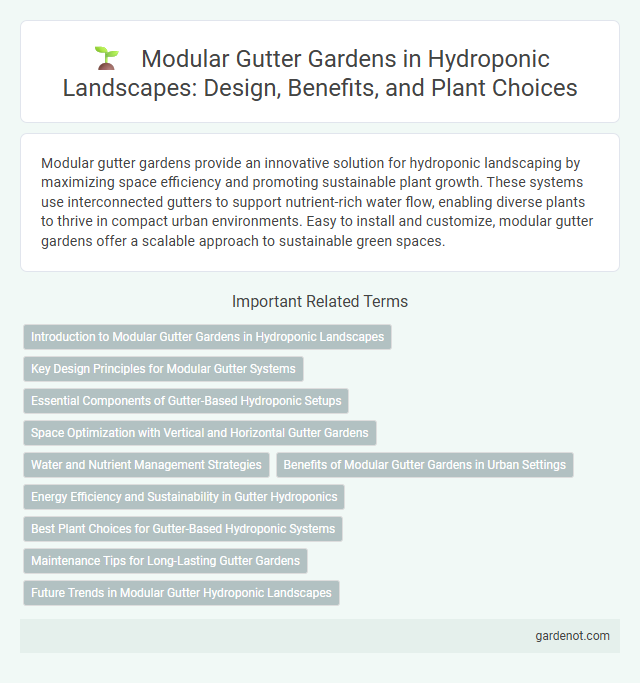Modular gutter gardens provide an innovative solution for hydroponic landscaping by maximizing space efficiency and promoting sustainable plant growth. These systems use interconnected gutters to support nutrient-rich water flow, enabling diverse plants to thrive in compact urban environments. Easy to install and customize, modular gutter gardens offer a scalable approach to sustainable green spaces.
Introduction to Modular Gutter Gardens in Hydroponic Landscapes
Modular gutter gardens in hydroponic landscapes utilize interconnected channels to support soil-free plant growth, optimizing space and nutrient delivery. These systems enhance water efficiency by recirculating nutrient-rich solutions through the gutters, promoting faster plant development and higher yields. Their scalable design enables customization for residential, commercial, and urban farming applications, making hydroponic gardening accessible and sustainable.
Key Design Principles for Modular Gutter Systems
Modular gutter garden systems emphasize efficient water management, ensuring even distribution and recycling within the hydroponic setup. Key design principles include maximizing space utilization through stackable, interlocking gutters that promote plant root aeration and accessibility. Durable, lightweight materials with UV resistance enhance system longevity while facilitating easy maintenance and scalability for diverse plant varieties.
Essential Components of Gutter-Based Hydroponic Setups
Modular gutter garden systems in hydroponic landscapes rely on essential components such as nutrient-rich water reservoirs, high-density polyethylene gutters, and efficient water circulation pumps to maintain optimal plant growth. Integrated drip emitters or net pots support seedlings, while tailored nutrient solutions ensure precise delivery of minerals. Properly designed support structures and filtration units prevent clogging and enhance overall system durability, maximizing yield in space-efficient environments.
Space Optimization with Vertical and Horizontal Gutter Gardens
Modular gutter gardens maximize space optimization by utilizing both vertical and horizontal configurations, allowing for efficient use of small or irregular areas. Vertical gutter systems increase plant density by stacking multiple growth channels, while horizontal arrangements expand growing space across wider surfaces. This dual approach enhances plant variety and yield in compact hydroponic landscapes, making it ideal for urban gardening and limited environments.
Water and Nutrient Management Strategies
Modular gutter gardens optimize water and nutrient management by ensuring precise delivery through a recirculating hydroponic system that minimizes waste and enhances plant uptake. Integrated sensors monitor moisture and nutrient levels, enabling real-time adjustments to maintain optimal growth conditions. This system promotes efficient resource use and supports sustainable urban agriculture in space-limited environments.
Benefits of Modular Gutter Gardens in Urban Settings
Modular gutter gardens maximize urban space by allowing efficient vertical farming on building walls and balconies, conserving soil and water resources through controlled hydroponic systems. These systems enhance air quality and reduce urban heat islands by increasing green cover without requiring extensive ground area. Easy installation and scalability make modular gutter gardens highly adaptable for diverse urban environments, promoting sustainable food production and aesthetic improvement.
Energy Efficiency and Sustainability in Gutter Hydroponics
Modular gutter gardens in hydroponic systems enhance energy efficiency by optimizing water and nutrient recirculation, reducing the need for constant pumping and minimizing electricity consumption. These gutter hydroponics designs promote sustainability through the use of recyclable materials and scalable configurations that conserve space and resources while supporting higher yield per square foot. Integrating energy-efficient LED grow lights with modular gutters further decreases energy usage, making the system eco-friendly and cost-effective for sustainable urban agriculture.
Best Plant Choices for Gutter-Based Hydroponic Systems
Lettuce, spinach, and kale thrive in modular gutter gardens due to their shallow roots and fast growth cycles, making them ideal for gutter-based hydroponic systems. Herbs such as basil, mint, and cilantro adapt well to limited nutrient film techniques within these setups, ensuring efficient nutrient absorption and consistent yield. Strawberries also perform exceptionally in gutter hydroponics, benefiting from controlled water flow and aeration provided by the modular design.
Maintenance Tips for Long-Lasting Gutter Gardens
Regularly clean modular gutter gardens to prevent algae buildup and root clogging, ensuring optimal water flow and nutrient delivery. Inspect and prune plants to promote healthy growth while avoiding overcrowding, which can reduce airflow and increase disease risk. Monitor water pH levels and nutrient concentration consistently, adjusting as needed to maintain balanced conditions favorable for hydroponic plant development.
Future Trends in Modular Gutter Hydroponic Landscapes
Emerging trends in modular gutter hydroponic landscapes emphasize automation and IoT integration for precise nutrient and water management. Vertical stacking and space-efficient designs enable urban agriculture scalability, optimizing yield per square foot. Sustainable materials and energy-efficient LED lighting enhance eco-friendly cultivation, driving innovation in future-ready hydroponic systems.
Modular gutter garden Infographic

 gardenot.com
gardenot.com